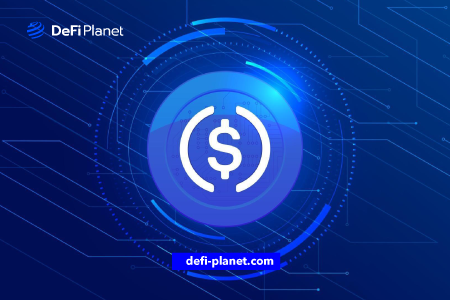Bitcoin and Ethereum command most of the attention in the cryptocurrency space because both coins dominate 60.6% of the crypto market.
However, countless additional blockchain and cryptocurrency projects aim to completely alter the global financial system. While investing in BTC or ETH could result in excellent rewards, one major issue with these cryptocurrencies is the high price volatility.
Price volatility is not new; it has existed since the inception of cryptocurrencies. Wild price swings might offer a chance for significant rewards for both seasoned and novice cryptocurrency investors. However, they can make cryptocurrency assets appear risky to some people.
Stablecoins, a type of digital currency with price stability, were developed to counteract these significant price swings. This article explores this kind of digital money and considers USDC.
What is USD Coin (USDC)?
USD Coin is a stablecoin pegged to the U.S. dollar. The coin was launched on September 26, 2018, in collaboration with Coinbase and Circle. USDC is a substitute for other cryptocurrencies backed by U.S. dollars, like TrueUSD (TUSD) and Tether (USDT).
Simply put, USD Coin is a service that tokenizes U.S. dollars and makes it easier for people to use them on the internet and public blockchains. Additionally, USDC coins can always be converted back to USD. Issuing and redeeming USDC coins is secured with the aid of an ERC-20 smart contract.
Putting U.S. dollars on the blockchain enables instantaneous transfers to any location in the world and provides cryptocurrencies with much-needed stability. It also creates new possibilities for lending, trading, risk hedging, and other activities.
What Purpose Does USDC Serve?
USDC is a tokenized representation of the U.S. dollar (USD). It is entirely redeemable and entitles you to exchange it for the cash you used to fund your account. Customers can rapidly and affordably move value anywhere in the world with the help of USDC. USDC’s value is directly linked to the U.S. dollar, unlike several stablecoins that are connected to the price of a single item or a basket of assets. Cash and short-term U.S. Treasury securities make up the USDC reserves maintained in segregated accounts with regulated U.S. financial institutions in the U.S.
The USDC protocol was developed to give the general public easier access to cryptocurrencies. USDC was created so that the crypto industry can be user-friendly.
Also, USDC was created for both commercial and private use. Due to USDC’s provision of an open-source smart contract, other businesses are free to create their blockchain-based services, such as wallets and exchanges. However, through USDC’s Payouts solution, individuals who want to use the U.S. dollar as a payment or reward system for their clients, staff, or partners can easily access these services.
How USDC Works
According to Circle, every USDC coin will be backed by a single U.S. dollar. Tokenization is the process of converting U.S. cash into USDC tokens.
There are three steps involved in tokenizing USD into USDC:
- A user transfers USD to the bank account of the token issuer.
- The issuer generates an equivalent quantity of USDC using a smart contract for USDC.
- The freshly minted USDC is given to the user, and the U.S. dollars that were substituted with it are kept in reserve.
Unless the process is reversed, it is easy to redeem USDC for USD (it’s as easy as minting USDC):
- A user requests that the USDC issuer exchange USD tokens for an equivalent amount of USD.
- The issuer requests that the USDC smart contract convert the tokens into dollars and remove an equivalent number of tokens from circulation.
- The issuer returns the desired amount of USD from its reserves to the user’s bank account. The user receives the net amount, which is equal to the amount in USDC tokens less any fees paid.
Unlike Tether (USDT), the creators of the USD Coin are required to maintain full reserves of the comparable fiat currency while cooperating with several financial institutions.
All USDC issuers are required to report their USD holdings regularly, and Grant Thornton LLP then publishes those reports.
Use Cases for USDC
Since USDC is a stablecoin, its applications far outweigh those of other cryptocurrencies, which are frequently too unstable to be used for regular transactions. Hence, USDC can be used for the following:
Hedge against volatility
USDC can be used as a hedge against the volatility of other cryptocurrencies because it is backed by the United States Dollar. For instance, if an investor owns ETH and the price starts to decline, the investor can consider converting some of it into USDC rather than selling it and accepting a loss. The USDC can be changed into ETH later when the price of ETH rebounds, thereby serving as a stable form of currency to store while the price is down.
Stable price-pegging
USDC can be used to represent equity or other assets with a dollar value but varying market prices. For instance, if an investor owns stocks, other assets, or commodities valued in dollars but the dollar’s value fluctuates, the investor can use USDC to preserve the value of his or her investment.
Blockchain interconnection
Due to USDC’s compatibility with several independent blockchains, it is possible to effortlessly integrate payment systems and applications. This makes it possible to quickly and easily move assets between various blockchain platforms without having to exchange one currency for another.
As a result, it is the perfect method for companies that operate across many jurisdictions or use different blockchains. For instance, a business using Ethereum to power its smart contracts but requiring Bitcoin payments may convert ETH to BTC using USDC.
Difference Between USDC and Other Stablecoins
Cryptocurrency stablecoins can be grouped into four categories:
Fiat-Collateralized
These comprise all stablecoins linked to a fixed amount of fiat currency. They are centralized. Examples include the USD Coin (USDC), TrueUSD (TUSD), Digix Gold (DGX), Tether (USDT), Paxos Standard Token (PAX), TrueUSD (TUSD), and Gemini Dollar (GUSD).
Crypto-Collateralized
They are stablecoins whose values are pegged to predetermined digital assets. Examples include Havven (nUSD & HAV) and Makercoin (MKR and DAI).
Algorithmic Non-Collateralized
These models aim to maintain stability in price without using collateralized assets. Examples include Fragments, Kowala, and Basis.
Hybrid
These are stablecoins that use a combination of the methods mentioned above. Carbon is an example.
USDC belongs to the first category. It is a centralized stablecoin. Generally, there aren’t many differences between the projects that fall under the same category and how they all operate. The two that stick out the most are Digix Gold (DGX), whose value is tied to gold, and Tether (USDT), which is infamous for refusing to perform a genuine public audit.
The remaining stablecoins with fiat collateral are released regularly and are backed by U.S. dollars. Their main differences center on their price structures and various partner organizations, although the business strategy largely remains the same.
Pros and Cons of USDC
Pros
Security
Since USDC is a digital asset, you can keep it in a cryptocurrency wallet. This benefit adds an extra degree of security because USDC is not owned by a single entity and is secured by the Ethereum blockchain’s encryption. It is also secured by any additional security measures the platform may have implemented.
Blockchain connectivity
Due to its Ethereum blockchain foundation and compatibility with all Ethereum-based protocols and apps, USDC may be easily integrated into current platforms and systems.
Stability
The main benefit of USDC is that it is a stablecoin, which means the value is always pegged to the U.S. dollar. Hence, it is less volatile than other cryptocurrencies. This makes it appropriate for use in areas where stable prices are crucial, such as payment processing or invoicing.
Regulated and audited
Since USDC is a regulated and audited currency, it satisfies all monetary and legal regulations while enjoying the benefits of blockchain technology.
Transparency
The Ethereum blockchain maintains a record of every USDC transaction. This public ledger offers a high level of transparency by making it easy to track and validate transactions.
Cons
Stablecoin competition
There are other stablecoins available besides USDC. Some of these stablecoins include Tether (USDT) and DAI. These coins have slightly different features than USDC yet provide advantages similar to USDC. This rivalry can result in less interest in USDC and a consequent drop in price.
Limited price growth
Since USDC’s value is pegged to the dollar, it doesn’t have the same potential for price growth as other cryptocurrencies. Therefore, while investors can benefit from a consistent return on their investments as the value of USDC often stays stable, they won’t be able to profit from any unexpected price spikes as they can with other assets.
In Conclusion,
- USD Coin is one of the leading stablecoins and plays a significant role in the global adoption of cryptocurrencies.
- Developed through a collaboration with Coinbase and Circle and managed by the renowned open source project centre, USDC is one of the most reliable stablecoins available right now.
- Stablecoins like USDC can make cryptocurrencies more attractive to institutional investors, thereby bringing cryptocurrencies to the mainstream.
Disclaimer: This article is intended solely for informational purposes and should not be considered trading or investment advice. Nothing herein should be construed as financial, legal, or tax advice. Trading or investing in cryptocurrencies carries a considerable risk of financial loss. Always conduct due diligence.
If you would like to read more articles like this, visit DeFi Planet and follow us on Twitter, LinkedIn, Facebook, and Instagram.
“Take control of your crypto portfolio with MARKETS PRO, DeFi Planet’s suite of analytics tools.”





















